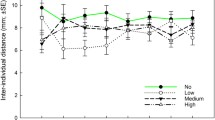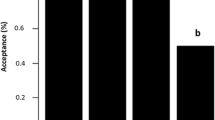Abstract
Gregariousness in animals is widely accepted as a behavioral adaptation for protection from predation. However, predation risk and the effectiveness of a prey’s defense can be a function of several other factors, including predator species and prey size or age. The objective of this study was to determine if the gregarious habit of Malacosoma disstria caterpillars is advantageous against invertebrate natural enemies, and whether it is through dilution or cooperative defenses. We also examined the effects of larval growth and group size on the rate and success of attacks. Caterpillars of M. disstria responded with predator-specific behaviors, which led to increased survival. Evasive behaviors were used against stinkbugs, while thrashing by fourth instar caterpillars and holding on to the silk mat by second instar caterpillars was most efficient against spider attacks. Collective head flicking and biting by groups of both second and fourth instar caterpillars were observed when attacked by parasitoids. Increased larval size decreased the average number of attacks by spiders but increased the number of attacks by both stinkbugs and parasitoids. However, increased body size decreased the success rate of attacks by all three natural enemies and increased handling time for both predators. Larger group sizes did not influence the number of attacks from predators but increased the number of attacks and the number of successful attacks from parasitoids. In all cases, individual risk was lower in larger groups. Caterpillars showed collective defenses against parasitoids but not against the walking predators. These results show that caterpillars use different tactics against different natural enemies. Overall, these tactics are both more diverse and more effective in fourth instar than in second instar caterpillars, confirming that growth reduces predation risk. We also show that grouping benefits caterpillars through dilution of risk, and, in the case of parasitoids, through group defenses. The decreased tendency to aggregate in the last larval instar may therefore be linked to decreasing predation risk.




Similar content being viewed by others
References
Addy ND (1969) Rearing the forest tent caterpillar on an artificial diet. J Econ Entomol 62:270–271
Benrey B, Denno RF (1997) The slow-growth–high-mortality hypothesis: a test using the cabbage butterfly. Ecology 78:987–999
Botham MS, Kerfoot CJ, Louca V, Krause J (2005) Predator choice in the field; grouping guppies, Poecilia reticulata, receive more attacks. Behav Ecol Sociobiol 59:181–184
Botham MS, Kerfoot CJ, Louca V, Krause J (2006) The effects of different predator species on antipredator behavior in the Trinidadian guppy, Poecilia reticulata. Naturwissenschaften 93:431–439
Castellanos I, Barbosa P (2006) Evaluation of predation risk by a caterpillar using substrate-borne vibrations. Anim Behav 72:461–469
Clark BR, Faeth SH (1997) The consequences of larval aggregation in the butterfly Chlosyne lacinia. Ecol Entomol 22:408–415
Cohen JE, Pimm SL, Yodzis P, Saldana J (1993) Body sizes of animal predators and animal prey in food webs. J Anim Ecol 62:67–78
Costa JT (1993) Larval ontogeny and survivorship of eastern tent caterpillar colonies. J Res Lepid 32:89–98
De Clercq P, Wyckhuys K, De Oliveira HN, Klapwijk J (2002) Predation by Podisus maculiventris on different life stages of Nezara viridula. Fla Entomol 85:197–202
Despland E, Le Huu A (2007) Pros and cons of group-living in the forest tent caterpillar: separating the roles of silk and of grouping. Entomol Exp Appl 122(2):181–189
DeVito J (2003) Metamorphic synchrony and aggregation as antipredator responses in American toads. Oikos 103:75–80
Evans EW (1982) Influence of weather on predator/prey relations: stinkbugs and tent caterpillars. N Y Entomol Soc 4:241–246
Evans EW (1983) Niche relations of predatory stinkbugs (Podisus spp., Pentatomidae) attacking tent caterpillars (Malacosoma americanum, Lasiocampidae). Am Midl Nat 109:316–323
Fitzgerald TD (1995) The tent caterpillars. Cornell University Press, Ithaca
Fitzgerald TD, Costa JT (1999) Collective behavior in social caterpillars. In: Detrain C, Deneubourg JL, Pasteels JM (eds) Information processing in social insects. Birkhauser, Basel
Gaston KJ, Chown SL, Styles CV (1997) Changing size and changing enemies: the case of the mopane worm. Acta Oecol-Int J Ecol 18:21–26
Grisdale D (1985) Malacosoma disstria. In: Singh P, Moore RF (eds) Handbook of insect rearing. Elsevier, Amsterdam, pp 369–379
Hamilton WD (1971) Geometry for the selfish herd. J Theor Biol 31:295–311
Hass CC, Valenzuela D (2002) Anti-predator benefits of group living in white-nosed coatis (Nasua narica). Behav Ecol Sociobiol 51:570–578
Heinrich B (1983) Caterpillar leaf damage, and the game of hide-and-seek with birds. Ecology 64:592–602
Heinrich B (1993a) The hot blood insects: strategies and mechanisms of insect thermoregulation. Harvard University Press, Cambridge, MA
Heinrich B (1993b) How avian predators constrain caterpillar foraging. In: Stamp NE, Casey TM (eds) Caterpillars: ecological and evolutionary constraints on foraging. Chapman & Hall, New York, pp 224–248
Hunter AF (2000) Gregariousness and repellent defences in the survival of phytophagous insects. Oikos 91:213–224
Iwao S, Wellington WG (1970) The western tent caterpillar: qualitative differences and the action of natural enemies. Res Popul Ecol XII:81–99
Krause J, Godin J-GJ (1995) Predator preferences for attacking particular group sizes: consequences for predator hunting success and prey predation risk. Anim Behav 50:465–473
Krause J, Reeves P, Hoare D (1998) Positioning behaviour in roach shoals: the role of body length and nutritional state. Behaviour 135:1031–1039
Lawrence WS (1990) The effects of group size and host species on development and survivorship of a gregarious caterpillar Halisidota caryae (Lepidoptera: Arctiidae). Ecol Entomol 15:53–62
Lemos WP, Zanuncio JC, Serrao JE (2005) Attack behavior of Podisus rostralis (Heteroptera: Pentatomidade) adults on caterpillars of Bombyx mori (Lepidoptera: Bombycidae). Braz Arch Biol Technol 48:975–981
Levesque KR, Fortin M, Mauffette Y (2002) Temperature and food quality effects on growth, consumption and post-ingestive utilization efficiencies of the forest tent caterpillar Malacosoma disstria (Lepidoptera: Lasiocampidae). Bull Entomol Res 92:127–136
McClure M, Despland E (2010) Collective foraging patterns of field colonies of Malacosoma disstria caterpillars. Can Entomol 142:1–8
McClure M, Cannell E, Despland E (2010) Thermal ecology and behaviour of the nomadic social forager. Malacosoma disstria. Phys Entomol. doi:10.1111/j.1365-3032.2010.00770.x
Mooring MS, Hart BL (1992) Animal grouping for protection from parasites: selfish herd and encounter-dilution effects. Behavior 123:173–193
Morris RF (1963) The effect of predator age and prey defense on the functional response of Podisus maculiventris Say to the density of Hyphantria cunea Drury. Can Entomol 95:1009–1023
Parry D, Spence JR, Volney WJA (1998) Budbreak phenology and natural enemies mediate survival of first-instar forest tent caterpillar (Lepidoptera: Lasiocampidae). Environ Entomol 27:1368–1374
Peters RH (1983) The ecological implication of body size. Cambridge University Press, Cambridge
Peterson SC, Johnson ND, LeGuyader JL (1987) Defensive regurgitation of allelochemicals derived from host cyanogenesis by eastern tent caterpillars. Ecology 68:1268–1272
Prop N (1960) Protection against birds and parasites in some species of tenthredinid larvae. Arch Néerl Zool 13:380–447
Reader T, Hochuli DF (2003) Understanding gregariousness in a larval Lepidoptera: the roles of host plant, predation, and microclimate. Ecol Entomol 28:729–737
Reavey D (1993) Why body size matters to caterpillars. In: Stamp NE, Casey TM (eds) Caterpillars: ecological and evolutionary constraints on foraging. Chapman and Hall, New York, pp 248–279
Rogovin K, Randall JA, Kolosova I, Moshkin M (2004) Predation on a social desert rodent, Rhombomys opimus: effect of group size, composition, and location. J Mammal 85:723–730
Ronnas C, Larsson S, Pitacco A, Battisti A (2010) Effects of colony size on larval performance in a processionary moth. Ecol Entomol 35:436–445
Schultz JC (1983) Habitat selection and foraging tactics of caterpillars in heterogeneous trees. In: Denno RF, McClure MS (eds) Variable plants and herbivores in natural and managed systems. Academic Press, New York, pp 61–90
Seyfarth RM, Cheney DL, Marler P (1980) Monkey responses to three different alarm calls: evidence of predator classification and semantic communication. Science 210:801–803
Smith GR, Awan AR (2009) The roles of predator identity and group size in the antipredator responses of American toad (Bufo americanus) and bullfrog (Rana catesbeiana) tadpoles. Behaviour 146:225–243
Tostowaryk W (1971) Relationship between parasitism and predation in diprionid sawflies. Ann Entomol Soc Am 64:1424–1427
Uetz GW, Boyle J, Hieber CS, Wilcox SR (2002) Antipredator benefits of group living in colonial web-building spiders: the 'early warning' effect. Anim Behav 63:445–452
Vulinec K (1990) Collective security: aggregation by insects as a defense. In: Evans DL, Schmidt JO (eds) Insect defenses. Adaptive mechanisms of prey and predators. State University of New York, Albany, New York, pp 251–288
Wajnberg E (2006) Time allocation strategies in insect parasitoids: from ultimate predictions to proximate behavioral mechanisms. Behav Ecol Sociobiol 60:589–611
Warren PH, Lawton JH (1987) Invertebrate predator–prey body size relationships: an explanation for upper triangular food webs and patterns in food web structure? Oecologia 74:231–235
Webb JK, Du W, Pike D, Shine R (2010) Generalization of predator recognition: velvet geckos display anti-predator behaviours in response to chemicals from non-dangerous elapid snakes. Curr Zool 56:337–342
Williams DJM, Parry D and Langor DW (1996) Sampling and identification of forest tent caterpillar parasitoids in the Prairie Provinces. Canadian Forest Service NR, Northern Forestry Centre:Information Report NOR-X-345
Acknowledgments
Thanks go to Dr. Don Stoltz (Dalhousie Univeristy in Halifax, Canada) for providing the facilities and insects to complete the parasitoid experiments. Experiments done at Dalhousie were possible due to financial assistance by Dr. Stoltz and a travel scholarship to MM awarded by Centre d’Étude de la Forêt. Financial support was provided by the Canadian Natural Sciences and Engineering Research Council as a Discovery Grant to ED, and by a Canadian Natural Sciences and Engineering Research Council Graduate Student Research Award to MM. The experiments comply with the current laws of the country in which they were performed.
Author information
Authors and Affiliations
Corresponding author
Additional information
Communicated by Sven Thatje
Rights and permissions
About this article
Cite this article
McClure, M., Despland, E. Defensive responses by a social caterpillar are tailored to different predators and change with larval instar and group size. Naturwissenschaften 98, 425–434 (2011). https://doi.org/10.1007/s00114-011-0788-x
Received:
Revised:
Accepted:
Published:
Issue Date:
DOI: https://doi.org/10.1007/s00114-011-0788-x




